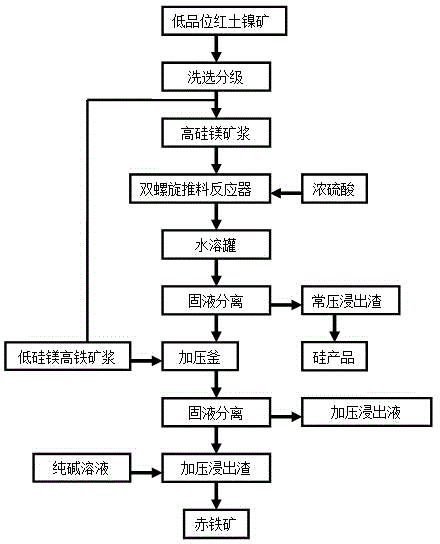Method of recycling nickel, cobalt, iron and silicon from low-grade laterite nickel ore through combined leaching process
A laterite nickel ore and combined leaching technology, applied in the field of cobalt, iron and silicon, and nickel recovery, can solve the problems of high acid consumption, long time, huge equipment, etc., and achieve the effect of low acid consumption
- Summary
- Abstract
- Description
- Claims
- Application Information
AI Technical Summary
Problems solved by technology
Method used
Image
Examples
Embodiment 1
[0042] Take 500Kg of washed and graded 2 # Add 500Kg of water to high-silicon magnesium ore (dry) to make high-silicon magnesium slurry, prepare 500Kg of concentrated sulfuric acid with a mass fraction of 98%, heat the high-silicon magnesium slurry to 60°C, and the concentrated sulfuric acid to 200°C, then use a mortar pump and concentrated The sulfuric acid pump synchronously feeds the heated high-silicon magnesium pulp and concentrated sulfuric acid into the feed port of the twin-screw pusher reactor. Dissolve soluble non-ferrous metals and soluble iron, and push the reaction materials out of the double-screw pusher reactor after reacting for 1 minute. Cool down to below 60°C, simply crush the reaction material of the loose honeycomb solid paste and pour it into a water immersion tank, add 1500Kg of water, stir for 30 minutes to dissolve in water, and pump the resulting slurry into a plate and frame filter press Solid-liquid separation and filter residue washing were carrie...
Embodiment 2
[0056] Take 500Kg of washed and graded 5 # Add 600Kg of water to high-silicon magnesium ore (dry) to make high-silicon magnesium slurry, prepare 500Kg of concentrated sulfuric acid with a mass fraction of 98%, heat the high-silicon magnesium slurry to 100°C, and the concentrated sulfuric acid to 150°C, then use a mortar pump and concentrated The sulfuric acid pump synchronously feeds the heated high-silicon magnesium pulp and concentrated sulfuric acid into the feed port of the twin-screw pusher reactor. Dissolve soluble non-ferrous metals and soluble iron, and push the reaction materials out of the double-screw pusher reactor after reacting for 12 minutes. Cool down to below 60°C, simply crush the reaction material of the loose honeycomb solid paste and pour it into a water immersion tank, add 1280Kg of water, stir for 30 minutes to dissolve in water, and pump the resulting slurry into a plate and frame filter press Solid-liquid separation and filter residue washing were car...
Embodiment 3
[0070] The normal-pressure acid leaching stage of the present embodiment is the same as that of Example 1, and 3 # Xinka low-silicon high-iron magnesium ore was replaced by 6 # Indonesian low silicon magnesium high iron ore.
[0071] Get 4000g of the 6 after washing and grading # Low-silicon-magnesium high-iron ore (dry), add 8000ml of washing liquid (E1) to prepare low-silicon-magnesium high-iron ore slurry, then move it into PARR4557 autoclave (17L), then add normal pressure leachate (B1) into the autoclave to make the reaction The final pH value of the material is 1.0, and it is leached under pressure for 60 minutes at a pressure of 2.18MPa and a temperature of 215°C. Fe in the normal pressure leaching solution (B1) 3+ Hydrolyze into hematite precipitation and release acid, then leaching low-silicon magnesium high-iron ore; after cooling down to 80°C, remove the reaction slurry from the autoclave for solid-liquid separation and wash the filter residue to obtain 3440g of p...
PUM
| Property | Measurement | Unit |
|---|---|---|
| particle size | aaaaa | aaaaa |
| quality score | aaaaa | aaaaa |
Abstract
Description
Claims
Application Information
 Login to View More
Login to View More - R&D
- Intellectual Property
- Life Sciences
- Materials
- Tech Scout
- Unparalleled Data Quality
- Higher Quality Content
- 60% Fewer Hallucinations
Browse by: Latest US Patents, China's latest patents, Technical Efficacy Thesaurus, Application Domain, Technology Topic, Popular Technical Reports.
© 2025 PatSnap. All rights reserved.Legal|Privacy policy|Modern Slavery Act Transparency Statement|Sitemap|About US| Contact US: help@patsnap.com



